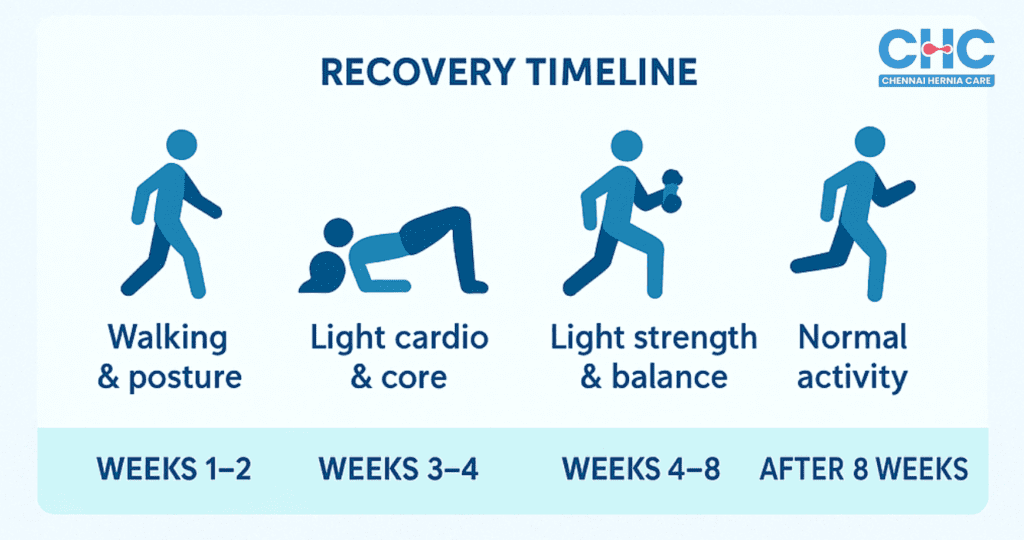Having an inguinal hernia (a bulge in the groin area when abdominal contents push through a weak spot in the lower abdominal wall) can raise the vital question: Can I still exercise? You’re here because you want to stay active, maybe do some gym or cardio, and you’ve found yourself searching for safe hernia exercises. This article is written for patients seeking clear guidance on what they can do, what they should avoid, and when they must see a hernia specialist in a nearby location.
Can You Actually Exercise with an Inguinal Hernia?
Yes. In many cases, you can do physical activity, but with caution, modifications and under specialist guidance. The keyword here is safe and controlled movements.
What research tells us
- Studies show that after hernia repair, patients are encouraged to return to regular physical activity as soon as the pain allows. [American Academy of Family Physicians+1]
- The literature is limited about exactly which exercises to do (especially before surgery) and how intense they can be. [PubMed]
- A review of abdominal wall hernia patients found exercise interventions improved quality of life, though pain reduction was less clear. [Lippincott Journals]
- On the flip side, lifting heavy weights, straining the abdominal wall, and high-impact movements can raise IAP and possibly worsen a hernia. [SpringerOpen+1]
Practical takeaway
If you have an inguinal hernia and want to do inguinal hernia exercises, you need to:
- Get your condition assessed by a specialist (especially a hernia specialist in Chennai if you are local)
- Avoid exercises that significantly increase IAP, like heavy lifting, maximal Valsalva (holding breath while straining)
- Focus on gentle core/stabilisation work, mobility, and low-impact cardio.
- If you are post-surgery, follow up with your surgeon about inguinal hernia surgery recovery time, exercise, when exactly you can start, and at what intensity.
So yes, you can work out with an inguinal hernia, but you must be wise.
Community Voices: Staying Active After an Inguinal Hernia
On a recent Reddit discussion about exercising with an inguinal hernia, one user shared their inspiring two-year journey of managing a hernia without surgery.
They described how stopping workouts initially led to weight gain and health issues like high triglycerides and fatty liver. With guidance from a doctor, they slowly returned to fitness, starting with walking, then brisk walking, and eventually interval running and bodyweight workouts.
Their main message was simple yet powerful:
“There is always a way forward. The worst thing you can do is stop moving; rest is rust.”
What we can learn:
- Gradual progress, not sudden intensity, makes a big difference.
- Light cardio and bodyweight exercises can be safe starting points.
- Regular medical check-ups and self-monitoring help prevent complications.
(Source: r/Hernia community thread used for educational discussion only. Always follow your doctor’s advice before trying any new exercise.
Key takeaway: Some people with an inguinal hernia manage broader workouts, but only when pain/discomfort is minimal, they have clearance, and they adjust their routine.
How-To Guide: Safe Hernia Exercises
Now let’s talk about inguinal hernia exercises you can do — and those you should avoid, both without surgery (conservative phase) and after surgery (recovery phase).
Phase 1: Conservative (before surgery or when the defect is minor and under specialist monitoring)
The main goal of hernia exercises is to stay active and gently strengthen your core without straining the hernia. It’s less about building abs and more about protecting your abdominal wall, improving blood flow, and reducing groin pressure.

Here’s how you can safely move your body if you have an inguinal hernia:
1. Walking: Start with regular, relaxed walks. It’s the simplest and safest form of exercise — keeps you moving, supports weight control, and helps digestion without putting pressure on your abdomen.
2. Stationary Cycling (Low Resistance): If walking feels comfortable, gentle cycling on low resistance is a good next step. Avoid sprinting or pushing against high tension.
3. Deep (Diaphragmatic) Breathing: Lie on your back or sit upright. Inhale deeply through your nose, allowing your belly to rise. Exhale slowly while gently tightening your lower abdomen. This strengthens the diaphragm and helps control intra-abdominal pressure (pressure inside your belly).
4. Abdominal Bracing: While lying down or sitting, pull your belly button slightly inward — as if trying to zip up tight jeans — and hold for a few seconds. This activates your inner core muscle (called the transverse abdominis), which supports the hernia area.
5. Bridge Pose: Lie on your back, knees bent, and feet flat. Slowly lift your hips until your shoulders, hips, and knees are in a straight line. Hold briefly, then lower down. This strengthens your glutes and lower back without stressing the groin.
6. Bird-Dog Exercise: On all fours, extend one arm and the opposite leg at the same time. Hold for a few seconds, then switch sides. It builds core stability gently and helps improve balance.
Doctor’s Tip: Wearing light compression shorts during these exercises can sometimes help you feel more supported and reduce discomfort.
Exercises and Activities to Avoid
While being active is helpful, some movements can make the hernia worse or increase your pain. Avoid (or do only with your doctor’s approval):
- Heavy lifting or weighted strength training
- Holding your breath while straining (known as the Valsalva manoeuvre)
- Ab exercises like crunches, sit-ups, or long planks, especially if they cause a bulge
- High-impact activities such as jumping, sprinting, or contact sports
Remember: If you notice increased swelling, pain, or pressure in your groin during any activity, stop immediately and consult your hernia specialist.
Tips:
- Always breathe out during exertion (to reduce intra-abdominal pressure).
- Keep progressing slowly. If you feel a bulge growing, pain, or any worsening of symptoms, stop and consult your specialist.
- Regularly check in with the hernia specialist to monitor if surgery becomes necessary.
Phase 2: After Surgery: Recovery and Safe Return to Activity
Once your inguinal hernia surgery is done, your focus shifts to healing, regaining strength, and gradually returning to your normal activities. The goal is to recover smoothly without rushing or putting too much pressure on the healing area.
What’s the Goal After Hernia Surgery?
- Allow your body to heal naturally.
- Rebuild gentle strength in your core and lower body.
- Prevent hernia recurrence
- Safely return to daily life, work, sports, or gym routines
Typical Recovery Timeline (and When to Exercise)
Recovery time varies depending on your surgery type: laparoscopic or open repair, and your general health.
Here’s a general guide to what you can expect:
- Laparoscopic repair: Most people can resume light activities like walking within a few days.
- Open repair or complex hernia: You may need 3–4 weeks before adding more movement or strength exercises.
Note: Always confirm with your surgeon before starting any post-surgery exercise. Healing times can vary from person to person.
A Gentle, Step-by-Step Return Plan

- Week 1–2: Rest & Light Movement
Start with short walks, gentle core activation (abdominal bracing), and focus on posture. Avoid lifting anything heavy. - Week 3–4: Light Cardio & Core
Add low-impact cardio like cycling or swimming. Include simple core exercises like bridging and bird-dog. Bodyweight squats are okay if pain-free. - Week 4–8: Gradual Strengthening
Reintroduce light strength training with higher reps and lighter weights. Focus on posture, balance, and controlled breathing. Avoid straining or holding your breath. - After 8 Weeks: Normal Activity with Caution
With your doctor’s approval, resume more intense workouts or sports. Continue avoiding heavy lifting or sudden high-pressure moves until fully recovered.
Doctor’s Tip: Healing doesn’t mean rushing. Even if you feel “normal,” your internal tissues may still be strengthening. Ease back in with patience — your body will thank you later.
Best Exercise for Inguinal Hernia: Doctor Suggests
If you ask “what is the best exercise for an inguinal hernia?”, the answer is: the one you can do safely, consistently, without pain or worsening, and which strengthens your core and abdomen without high strain.
Why core + stabiliser work matters:
- A strong core means better distribution of forces and less stress on the weak spot.
- Research shows post-operative rehab programs emphasise posture, body mechanics and core strengthening.
- Gentle stabiliser work is often safer than maximal “abs crunch” type work early on.
Example of a safe foundational move:
- Cat-Cow Breathing & Bracing: On all fours, inhale as you arch your spine (cow), exhale as you round your spine (cat) while pulling your belly button slightly in (activating “transverse abdominis”). Do 10–15 reps.
- The hernia exercises are used for the principle of core activation without high load or strain.
Progression tip: Once you are comfortable and cleared, move to bridging, bird-dog, side-plank, body-weight squats, and then eventually light resistance. But always monitor how your groin/hernia region feels.
What Activities Should You Avoid with an Inguinal Hernia?
Knowing what not to do is just as important as knowing which exercises to do. Certain movements can increase pressure inside your abdomen (intra-abdominal pressure), which may worsen your hernia or delay recovery.
Until your doctor or physiotherapist gives the all-clear, try to avoid or modify the following:
- Heavy lifting with strain especially barbell squats or deadlifts done with maximum effort. These create intense pressure inside the abdomen.
- Intense core workouts such as crunches, hanging leg raises, or explosive ab exercises that make you feel pain or bulging in the groin.
- High-impact or contact sports including sprinting, jumping, or tackling movements that jerk your core or lower abdomen.
- Holding your breath while lifting avoid the Valsalva manoeuvre (holding your breath and pushing), which can stress the hernia site.
- Sudden twisting or bending while carrying weight can strain the healing tissue.
Remember: You don’t have to stop being active, just focus on safer, low-pressure exercises until your body is ready. Always listen to your body, and check with your hernia specialist before returning to intense workouts or sports.
When to seek a Doctor for Hernia treatment
- You feel pain or discomfort regularly in the groin, especially with activity or strain.
- The bulge gets larger, becomes tender, or you cannot push it back in.
- You develop nausea/vomiting, redness or signs of strangulation (medical emergency)
- Your activity is severely limited, or you want to return to high-intensity sports or the gym.
In these cases, you should consult the best hernia surgeon in Chennai. They can assess whether your hernia is best managed conservatively or requires intervention.
Frequently Asked Questions:
In many cases, you can do gentle, controlled workouts and certain core stabilising exercises. But you must consult a doctor first, avoid heavy lifting or high-impact movements, and tailor your routine to your hernia’s size/symptoms.
You should avoid heavy lifting, high-impact sports, explosive core movements, holding breath during exertion (Valsalva) and any exercise that causes pain or increases the bulge. Progressive return under supervision is key.
Running may be okay if your hernia is small, you have a specialist’s clearance, you feel no pain, and you use proper technique (light jogging rather than sprints). But if you experience discomfort or changes in the bulge, refrain from further activity and seek advice.
Our Medical Review Process:
Our content goes through a structured review process to ensure medical accuracy and reliability.
Written By: Editorial Team, Chennai Hernia Care
Reviewed By: Dr. Deepak Subramanian, MS, FMAS – Laparoscopic & Bariatric Surgeon
Last Updated: October 13, 2025
